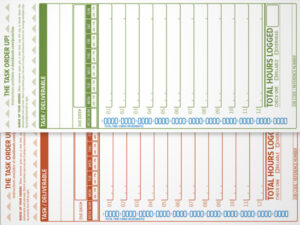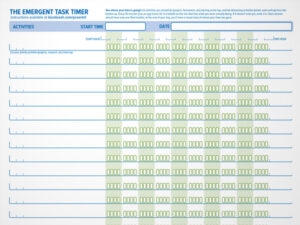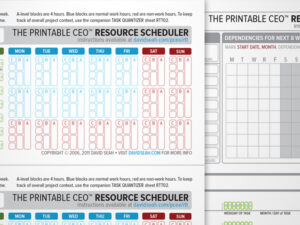Allocate Projects as Logical Chunks & Deliveries, Not Task Lists

One of the awful things about to-do lists is that you feel reward only when everything is checked-off. This is a distressingly-rare event, and you start to feel bad about not working fast enough.
To free myself from this trap, I made the Task Progress Tracker (TPT). It tracks effort in a useful way, not just done-ness. It also provide a “big picture” view of a project, which helps avoid the ickiness of micro-management. It’s an “I did” list, not a tyranical “to do” list.
How It Works
 The TPT is designed to provide an overview of a project and its subcomponent steps, focusing on problem solving rather than mechanical task completion. It does this by tracking time spent, not tasks completed. This allows you to be mindful at the “intention” level as you work toward solving your problem, which is appropriate when pioneering new processes or doing fundamental research. So long as you’re working, that’s great.
The TPT is designed to provide an overview of a project and its subcomponent steps, focusing on problem solving rather than mechanical task completion. It does this by tracking time spent, not tasks completed. This allows you to be mindful at the “intention” level as you work toward solving your problem, which is appropriate when pioneering new processes or doing fundamental research. So long as you’re working, that’s great.
To-do lists have their place as pre-flight lists and reminders. They are also workable for tasks that you know how to complete. When tackling something new, creative, or unknown, I don’t think they don’t work as well; they are like the untrained boss who bugs you every five minutes for results, without caring about how you get them. It’s oppressive!
So instead, track the effort you’re spending, using the TPT as a way to remind you how you’re planning on exploring then solving the problem in front of you. Use your higher-order thinking modes! If your thinking changes, fill out another TPT with your next theory, and keep going.
The Tracker Bar
 Effort is tracked in 15-minute increments. Timewise, you get up to 4 hours to complete each task. This is not arbitrary; I find that 4 hours is usually enough to get a solid task out of the way. If not, break it up.
Effort is tracked in 15-minute increments. Timewise, you get up to 4 hours to complete each task. This is not arbitrary; I find that 4 hours is usually enough to get a solid task out of the way. If not, break it up.
I think it’s self-explanatory, except for the effort box. This is used to mark tasks that are unexpectedly difficult. If you are getting stuck, you can “increase the difficulty rating” up to three time. Start by filling in the smallest circle. Blacken the entire circle out if it was really difficult. Award yourself a treat!
Who uses it?
I’ve heard that engineering team leads use the TPT for assigning projects, breaking them down into a series of steps and estimates. It’s stapled to the front of a folder.
 The second version of the form, the Destruct-o-Matic, was designed for users who want to treat tasks like enemies to be destroyed. Instead of bubbles, it uses miniature bullet holes.
The second version of the form, the Destruct-o-Matic, was designed for users who want to treat tasks like enemies to be destroyed. Instead of bubbles, it uses miniature bullet holes.
More Information
The first version of the TPT was created in November 2005. You can read the original post for more insight into each design feature. Enjoy!
Enjoy!







